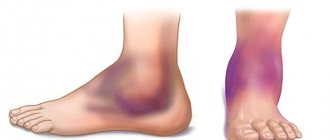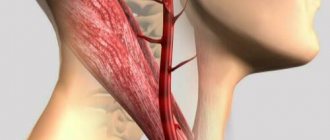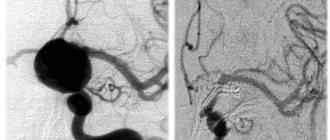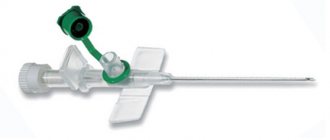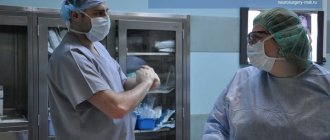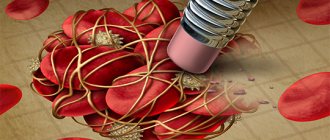Obliterating atherosclerosis is one of the main diseases that causes impaired blood supply to the lower extremities. The disease is associated with the accumulation of cholesterol in the artery wall, forming plaques that block the lumen of the artery. The arteries become hard and their patency is impaired. This pathology can lead to thrombosis of the affected artery with the development of acute ischemia. The disease usually develops in old age, often against the background of diabetes mellitus, although now relatively young patients also turn to a vascular surgeon.
Lack of blood supply leads to dysfunction of the muscles of the limb, this is manifested by fatigue when walking for some distance, and with severe decompensation of blood circulation, gangrene of the leg can develop.
Treatment of atherosclerosis at the Innovative Vascular Center
Our center was created as a clinic for modern treatment of atherosclerosis and its complications. In our clinic you can consult an experienced vascular surgeon and undergo the necessary instrumental examination. Receive recommendations for conservative treatment of uncomplicated vascular lesions, but the main thing is to fully cure critical ischemia with the help of vascular surgery.
The methods of vascular surgery used in our clinic have no analogues in Russia in terms of their effectiveness in the treatment of critical ischemia against the background of obliterating atherosclerosis. We focus on minimally invasive and microsurgical interventions, which have not yet become widespread in our country. We are able to save a leg in case of critical ischemia due to atherosclerotic blockage in 98% of all patients. We achieve such results thanks to reasonable approaches to treatment, impeccable attitude towards the interests of our patients, collegial decisions taking into account the opinions of related specialists and excellent diagnostic and treatment equipment.
How does the disease manifest itself?
With atherosclerosis of the extremities, a person begins to experience sharp pain when walking and lameness appears. After walking short distances, the patient feels terrible fatigue, stiffness in movements, cramps, and his toes go numb. It seems that the leg suddenly became unbearably heavy, as if a weight had been put on it. Typically, one leg is affected by atherosclerosis of the lower extremities. After rest, the pain goes away, but not for long.
Cause of numbness in legs
Probably each of us remembers this unpleasant feeling when our legs go numb and you simply can’t feel them. This includes tingling throughout the body, a “chill,” and a feeling of temporary paralysis of the limbs. There are different reasons for this:
- uncomfortable sitting position, when nerve endings are compressed;
- diabetes mellitus;
- poor circulation in the legs,
- manifestation of osteochondrosis;
- lack of vitamins in the body;
- migraine;
- multiple sclerosis;
- inflammation of the nerves in various diseases: arthritis, etc.
Fortunately, numbness in the legs is not always a harbinger of serious illness. However, this is always a reason to immediately contact a vascular surgeon.
Risk factors for the development of atherosclerosis of the lower extremities:
- age 40 -50 years;
- male gender;
- large amounts of alcohol;
- smoking;
- high cholesterol levels;
- diabetes mellitus;
- hypertension;
- stress;
- sedentary and sedentary lifestyle.
At-risk groups
Patients with the following problems are most susceptible to vascular diseases of the lower extremities:
· Long history of smoking;
· Diabetes mellitus types 1 and 2;
· Alcohol abuse;
· Prolonged physical inactivity;
· High blood pressure;
· Hypercholesterolemia (increased concentration of cholesterol and triglycerides in the blood);
· High level of non-proteinogenic amino acid homocysteine in the blood;
· Obesity;
· Severe hormonal imbalance.
Pathologies of blood vessels and arteries of the legs mainly affect people who have crossed the threshold of fifty years of age, but in the last few years their active spread has also been observed among the young population. Men are more susceptible to such diseases than women.
It should be emphasized that most vascular dysfunctions are of a psychological nature, and people with a stressful type of character are most susceptible to them.
It is important to have a family history of disorders. This is especially true for atherosclerosis and varicose veins.
Classification of stages of arterial insufficiency of the lower extremities
- Stage 1 (a person is able to walk freely for about a kilometer);
- Stage 2 (the patient is able to walk about 200 meters without pain);
- Stage 3 (a person can move less than 50 meters, he begins to be very bothered by “pain at rest”, in which even during a night’s rest the patient feels the need to lower his foot to the floor several times a night);
- Stage 4 (necrotic changes develop in the toes).
At the last stage of the disease, amputation is possible.
Symptoms of atherosclerosis of the lower extremities:
- lameness;
- rapid fatigue when walking;
- pain when walking in the calf muscles and thigh muscles;
- feeling of muscle contraction;
- numbness in the legs and a constant feeling of coldness in the extremities;
- in the stage of exacerbation of the disease, the color of the skin on the affected leg may change, it will become a pale bluish tint.
A more severe stage of the disease is characterized by the following symptoms:
- increasing lameness;
- legs constantly go numb;
- the pulse cannot be felt during palpation in the popliteal fossa, on the ankle and thigh;
- pain not only when walking, but also at rest;
- insomnia at night due to pain and numbness in the legs;
- cyanosis of the skin, the skin becomes brownish-red in color, hair falls out on the skin of the legs, nails peel, ulcers appear on the heel and toes.
Chronic arterial insufficiency of the lower extremities affects 2-3% of the population, while obliterating atherosclerosis of the arteries accounts for 80-90%. Unfortunately, at present KHOZANK has become much younger. If previously older men suffered from these diseases, now they affect even young men and girls. There is a high risk of developing diseases in this group in smokers. When smoking 20 cigarettes a day, the risk of developing COPD increases 4-6 times. Every year, tens of thousands of people die as a result of obliterating atherosclerosis of the vessels of the legs.
Symptomatic interventions:
- Sympathectomy
(intersection of the nerve plexuses responsible for spasm (narrowing) of the arteries) is performed for repeated blockages of the arteries and in addition to reconstructive operations. This operation improves blood circulation in the extremities by dilating small arteries. - Revascularization osteotomy
is also an adjuvant technique that improves blood circulation by stimulating the formation of new small vessels in the lower extremities after bone injury. - Arterialization of the venous bed
is rarely used at this time, since its implementation is associated with various technical difficulties, and long-term results are worse than the methods described above.
Prevention methods
For prevention purposes, you need to start controlling the levels of lipids, sugar and cholesterol in the blood as early as possible. Even with a slight increase in numbers relative to the norm, you should consult a doctor. It is also recommended to regularly do ultrasound of the lower extremities - once every 1-2 years.
It is important to watch your diet, because the reason for the increase in “bad” cholesterol in the blood is the saturated fats that we consume in food. These are products of animal origin - fatty meat, lard, butter. There is a lot of cholesterol in eggs, or rather in the yolks. All these products should be consumed in the smallest possible quantities.
| Name of service (price list incomplete) | Price, rub.) | In installments* |
| Appointment (examination, consultation) with a cardiovascular surgeon, primary, therapeutic and diagnostic, outpatient | 1 750 | — |
| Program “Risk of atherosclerosis and ischemic heart disease, predisposition to dyslipidemia” | 19 000 | — |
* You can read more about the conditions here - Treatment on credit or in installments.
Diet therapy
Usually the diet is prescribed for life. Any form of atherosclerosis is endogenous and completely depends on the diet and lifestyle of the patient. The table below shows permitted and prohibited products.
| Allowed | Prohibited |
| Lean meats – chicken, turkey, beef | Fatty meats, lard |
| Fish | Trans fats (margarine, spread) |
| Fresh fruits, vegetables | Sausages, frankfurters, other smoked meats |
| Sea kale | Mayonnaise, all fatty sauces |
| Bran, cereals | Fast food |
| Low-fat dairy products, cheeses | Fatty dairy products, cheeses |
| Chicory, herbal teas | Baking, flour |
Fast food is considered one of the most harmful foods that provokes high cholesterol, it is especially important to give it up for life
Common diseases of blood vessels and arteries of the legs
Due to the global spread of vascular pathologies of the lower extremities, some people consider them to be normal, since disorders associated with them are observed in every second adult patient. But this does not mean that these diseases do not need treatment. Neglecting their therapy can result in extremely serious complications, therefore, if alarming symptoms are detected, it is important to consult a doctor for differential diagnosis and selection of the correct treatment tactics.
In medical practice, such diseases are divided into several groups:
Atherosclerosis obliterans (OAOS) is a chronic degenerative metabolic process associated with hardening of arterial walls against the background of excessive deposits of lipids and cholesterol. These substances, in turn, become catalysts for the formation of atherosclerotic plaques, which can gradually narrow the lumens of blood vessels and lead to their absolute closure, associated with impaired nutrition and tissue viability.
Atherosclerosis is one of the leading causes of disability and mortality worldwide. Its characteristic features:
- pain in the legs, aggravated by running, climbing stairs and fast walking,
- intermittent claudication syndrome.
Obliterating endarteritis is a rapidly progressing disease of the arteries of the legs, associated with a gradual narrowing of the lumen of blood vessels and necrosis of tissues deprived of blood supply. The nature of the pathology has not been thoroughly studied, but doctors consider the key cause to be an inflammatory process associated with the predominance of autoimmune antibodies in the vessel.
Signs of the disease:
- rapid fatigue of the limbs when walking,
- sudden cooling of the extremities without objective reasons,
- swelling,
- formation of ulcers.
Acute arterial obstruction is a disease that occurs as a result of an abnormal increase in blood clotting (hypercoagulation), as well as against the background of an inflammatory or atherosclerotic process, leading to modification of the vascular walls and a sudden cessation of blood flow. This pathology often causes acute arterial ischemia syndrome.
It is expressed mainly in arterial spasm of both the affected and healthy legs.
Varicose veins are a common disease characterized by degenerative changes in the superficial veins, in which there is a loss of their elasticity, stretching, rapid growth and the formation of additional nodes.
The symptoms of this pathology are quite specific:
- congestive swelling of the legs,
- convulsions,
- change in skin pigmentation,
- feeling of heaviness
- soreness and fatigue,
- Characteristic bumpy nodes appear under the skin, often accompanied by itching and burning.
This pathology is accompanied by such aggressive complications as acute thrombophlebitis and intense bleeding.
Thrombosis of the superficial venous system is a syndrome that often results from varicose veins with an adjacent infectious process.
Signs:
- severe hyperemia and acute pain in the limbs,
- the occurrence of infiltrates localized along the course of the affected vein.
Venous thrombosis is the process of thrombus formation associated with dysfunction of coagulation and blood flow, inflammation or disruption of the integrity of the venous wall.
Signs:
- rapidly growing swelling of the limb,
- severe hyperemia and hyperthermia,
- cutting pain
- bluish skin at the site of injury,
- arterial spasms.
An aneurysm is a diffuse or saccular protrusion of part of an artery associated with an expansion of the lumen of a blood vessel and a decrease in its tone (excessive stretching or thinning of the wall).
The disease manifests itself in:
- limb weakness,
- periodic pain that tends to subside on its own,
- numbness, pulsation, coldness of the affected area,
- formation of a tumor-like neoplasm under the skin.
Vascular network (telangiectasia) is an abnormal proliferation of subcutaneous capillaries, accompanied by a local accumulation of thin capillary lines of a blue, red or purple hue, resembling a cobweb, an asterisk or a chaotic mesh in shape. It is painless and does not pose a potential risk to the health and life of the patient. Amenable to gentle surgical and hardware treatment. In the vast majority of cases, it brings purely aesthetic discomfort to the patient.
Diagnostics
To confirm the diagnosis and clarify the severity of the disease, additional diagnostic methods are needed:
- Ultrasound Dopplerography of the arteries of the lower limbs with measurement of the pressure ratio on the arm and leg, which normally should be close to unity
- duplex scanning of arteries of the artery is a method that allows not only to assess the blood flow in the vessel, but also to see the vessel itself and changes in its walls
- conducting stress tests (treadmill test, i.e. walking on a treadmill under certain conditions)
- according to indications, it may be necessary to conduct a contrast study of the arteries of the heart - multislice computed tomography or angiography of the aorta and arteries of the lower extremity
Causes
The main reason for clogging of arteries due to the formation of cholesterol plaques in the inner lining is a violation of lipid metabolism in the body. Often the person himself is to blame for this condition; it arises due to an incorrect lifestyle. The most common provocateurs of nonstenosing atherosclerosis are:
- obesity;
- smoking, alcohol abuse, drug use;
- sedentary lifestyle;
- hypertension (high blood pressure);
- improper diet with excessive amounts of animal fats;
- genetic predisposition;
- constant stress.
Usually, the formation of plaques in the arteries occurs when several factors appear simultaneously. For example, hypertension in people over 45 years of age occurs in every second person. If a person has bad habits and does not play sports, the likelihood of developing non-stenotic atherosclerosis increases significantly.
Some people don't understand how bad habits relate to arterial health. The thing is that under the influence of alcohol, nicotine, and other negative factors, the elasticity of the walls of blood vessels decreases, which makes them a favorable basis for the appearance of plaques.


